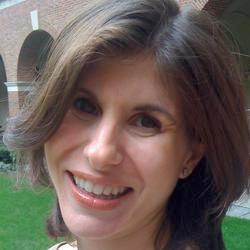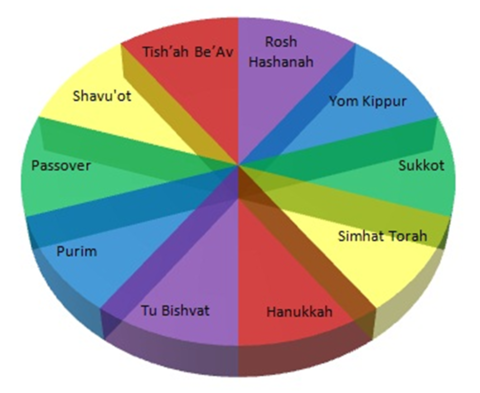Parts of a Whole

A strange fact about being human: we never see any object in its entirety. We perceive in three dimensions, but see only in two so that our seeing is always at the mercy of our believing. Art historian David Rudd Cycleback, in his online collection of essays, describes this well:
Not only are things like coffee cups and sticks and tree branches partially visibly obscured by overlapping other objects, but we can never see all sides and parts of an object at once. Even with an apple you’ve turned in your hands, you can’t be sure whether it’s fresh or rotten in the core until you bite or cut it apart. Humans live and learn in an environment where information is always obscured or otherwise hidden from view.
Given this fact, we know that we need many sources to inform our perceptions of reality. It is with a great sense of wonder, then, that we recognize in our own holiday cycle many parts that add up to a whole: a microcosm of this basic truth. In fact, as we look more closely, we notice a pattern in the cycle, one that requires the whole to be laid out before us so that we may fully appreciate it:

Seen as a two-dimensional whole, we understand that certain themes experienced from a particular angle on one holiday are revisited from another angle on another holiday; and, in fact, that those themes and holidays lie directly opposite from one another in the calendar cycle. So, for example, Passover and Sukkot, both in green above, our two weeklong holidays celebrate (a) the beginning of the harvest and its culmination and (b) the Exodus from Egypt and God’s protection during the ensuing years of wandering. One occurs in the spring; the other, directly opposite, in the fall. Or Hanukkah and Tish’ah Be’Av, in red on the chart above: one is a celebration of light during the shortest, darkest days of the year, and the other is a day of darkness during our brightest season. One celebrates miracles and military victory, and the other marks tragedies and political defeat; one, the rededication of the Temple, and the other its destruction. If we celebrate only Passover, but not Sukkot; only Hanukkah, but not Tish’ah Be’Av, then we experience only a small portion of the reality and the wholeness that the totality of the holiday cycle enables us to live out.
This brings us to the holiday so soon upon us, Purim. Since Purim sits directly across from Yom Kippur on our chart above, we wonder: what connects these two most disparate of holidays? Yom HaKippurim k’purim puns the Zohar (“Yom Kippur is like Purim,” a pun on the close sound of the Hebrew), and, ever since this was written in the 13th century, rabbis have wondered just how the two might be alike—what the Zohar could have meant.
At its most superficial, we understand the two to be diametric opposites. Yom Kippur is solemnity; Purim is lightheartedness. On Yom Kippur, we fast and afflict our souls; on Purim, we feast, drink, and tell jokes. If on Yom Kippur we take ourselves seriously, on Purim we mock ourselves and make light of life.
More deeply than this, Yom Kippur is a day in which we insist that there is a God who sits in judgment of us. It is the day on which we comfort ourselves with the awesome yet soothing consolation that there is a God watching over us, a God who cares about what all of us do as individuals and, not unlike Santa Claus, a God that keeps track of who is naughty and who is nice—and also that this God has the power to grant us life. So if we give full expression to our consciences, then we will be granted teshuvah, the chance for more time to do things better.
On Purim, we insist just the opposite. We read the Megillah, which does not mention God even once. We sense that the miracles of the story come about by nature or coincidence; that we have only ourselves to rely on because life is a game of lots (purim), and our fate has only to do with the luck of the draw. Purim is the holiday in which we declare that life is chaos, God seems absent from our lives, none of us knows what is right or wrong (the Talmud suggests we drink until we cannot distinguish between Haman and Mordecai [BT Megillah 7b]), and we celebrate because we are alive and must adopt an attitude of making the best of it.
Either one of these holidays gives us only a partial truth. Together, they make a whole.
We who cannot perceive things in their wholeness sense only a contradiction here. We spend most of our days insisting that either God exists and rules over us or does not; that there is a structure and system of rules at work governing our lives, or there is not. But our actual experience of life is that we can only see part of the apple at any given time; in reality, we experience both God-is-in-charge, Yom Kippur-like moments as well as life-is-a-game-of-chance, Purim-like moments. We go through stages of life in which we foster deep faith, and others when we throw up our hands in bewilderment. We sit and argue with friends about faith and whether there is a God or not, and we know that the truth lies somewhere between the two seemingly contradictory positions that life is full of Yom Kippur days and Purim days, and that the parts add up to the whole.
Since we can never experience the whole but only the parts, we have no choice but to live day by day, one holiday at a time, with its particular message for us. This weekend, we celebrate Purim. We celebrate the miracles of life’s good fortune and with light hearts we will throw a masquerade party. But we know that this is part of a larger truth, and that the great wisdom of Jewish living is one in which the cycle of the year brings us in touch with all that we need, one revelation at a time, for spiritual wholeness.
The publication and distribution of the JTS Commentary are made possible by a generous grant by Rita Dee and Harold (z”l) Hassenfeld.



